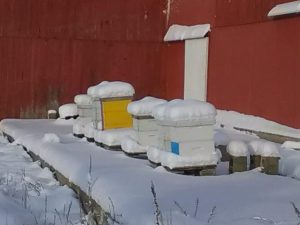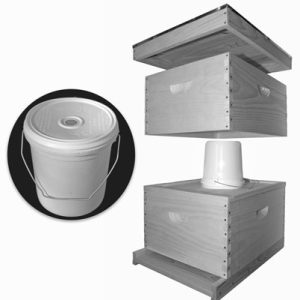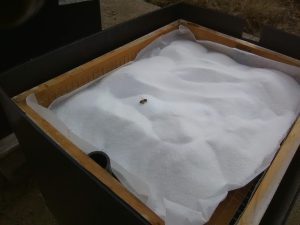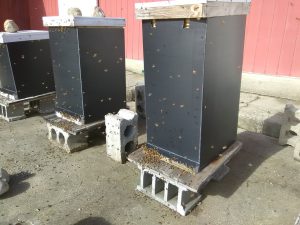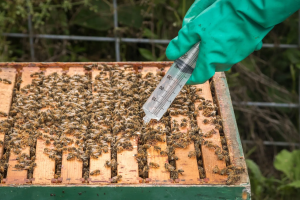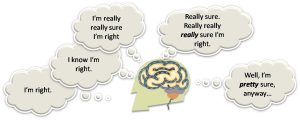By: Shana Archibald
Ingredients
□ 2 cups of milk (you can use coconut, almond or cow)
□ ½ cup of honey
□ ⅓ cup of peanut butter
□ 1 tsp baking powder
□ 1 tsp vanilla extract
□ 1 tbsp flax seed
□ 2 cups rolled oats
□ ¼ cup cocoa powder
□ ½ cup chocolate chips (or more! Measure it with your heart haha!)
□ Pinch of salt
Directions
Step 1
Preheat oven to 350°F
Step 2
Combine everything into a large mixing bowl and stir.
Step 3
Place into a 9×13 baking dish and bake for 40 minutes. Enjoy!
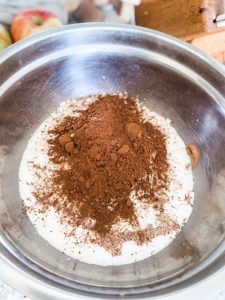



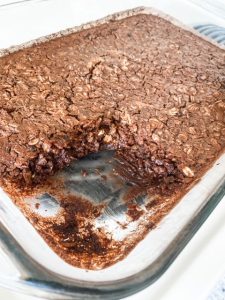
By: James Masucci
It’s been a year and a half since I retired from my day job and started focusing on beekeeping full time. I have since bought a bee truck, built a honey house and done many splits to expand my operation. I was talked into writing these articles, to help other beekeepers who were thinking about doing the same thing. These were never meant to be “how to” articles, but rather “learn from my experience”.
In general, I’ve gotten a lot better. There is a big difference dealing with 200 hives than dealing with 80 hives. I imagine people with 500 hives say the same thing compared to 200. It’s about efficiency and planning. So, what have I learned?
Have a plan:
I heard a seminar by John Miller where he said, “know what you are going to do and know what you are not going to do”. This is good advice and much more profound than it sounds. For example, I have always built my own hive equipment. I have a friend who repurposes crate lumber and I can build deep boxes for $5.00 each. That works well when you need to build 30-50 or fewer. But when you want to double in size from 100 to 200+, that’s a lot of equipment to build. The workload from that expansion also increases, but the hours in a day stay constant. Think carefully, where do you want to spend your time? For the first time, I ordered deep and medium boxes AND ordered assembled frames. Due to the timing, the time it saved me was well worth the cost.
A corollary to this lesson, what is your business model? I decided to be a stationary beekeeper. No pollinating and no chasing nectar flows in neighboring states. I sell nucs, local honey and raise queens to supply my own colonies. Sounds easy enough. Until I took too many orders for overwintered and Spring nucs and had a larger than expected Winter kill. Hmmm, all of a sudden, I didn’t have the production hives that I wanted and ended up producing 20% less honey than I wanted to. It took some thought and some calls to some commercial beekeeper friends of mine for me to come up with a strategy. First, don’t mess with the production hives. Instead, make a lot of timely, Summer splits in a way that doesn’t impact honey production (but, not enough equipment…). Those splits are dedicated to my nuc business and replacing colonies that don’t survive. But this is just an example. Everything you do with your bees impacts your operation. What’s your focus and what’s secondary. You will, ultimately, need to choose.
Plan your outyards. When beekeepers first start to expand, usually they aren’t choosy about where their bees go. A friend has some property an hour away, so they put a couple hives out there. Now, expand to twenty yards. The amount of time wasted in the vehicle, let alone the gas burned is incredible. So think about this up front. I also have criteria for new yards. I need easy access (not the case in my “hobby” loop), I want at least 10 hives with no potential neighbor issues, and it must be within 15 minutes of one of my loops (without going farther).

Picture 1. Plan your outyards. My three outyard loops: locations of yards are starred with number of hives in each listed. The green loop represents my hobby years with relatively few hives and a lot of travel time. The red line is my start into “serious” beekeeping. The blue line is my latest loop.
I now have three loops of yards (see picture 1). The northwestern loop (blue) consists of four yards and 120+ colonies, the southwestern loop (red) of four yards and 70+ colonies and the local loop (green) consisting of four yards and 26 colonies. It’s now time for me to “edit” these loops by asking if the time is worth the harvest? Most yards averaged two supers per hive. One, however averaged three and one averaged 0.5. I will put more hives on one and delete the other. By evaluating the health and harvest at each yard, you can adjust the size and improve your efficiency.
Have the right equipment:
The more hives you get, the more efficient you need to be. Having the right equipment greatly improves efficiency. In the name of efficiency, you want to make one trip per day to your home base. That means you carry everything you need for the day to your yards and return when all the work is done. Every time I need to return to get more equipment/supplies, it’s a waste of hours. For me, getting a bee truck was phenomenal (see picture 2). Just being able to collect all my honey supers for one loop in one trip was worth it. I also can carry totes of sugar syrup for feeding, scores of boxes and other equipment for splitting and a myriad of other things. I don’t drive the truck every time I go to the bees, but when I need it, it’s invaluable. I also put on a lift gate, which allows me to load things and move them on pallets, greatly minimizing the number of times I need to lift what I’m moving. In addition to bee equipment, I can now buy pallets of sugar, loads of lumber and other things too big for a pickup truck.
But, along with all the pros to having a bee truck, there is also a learning curve. On one honey getting trip, I had two load shifts. In fact, there used to be four deep boxes of honey in the empty column seen in picture 2. They came off on a turn in the highway. Fortunately, on the side of the road and there was no traffic incidents associated with it. Needless to say, drive and load carefully. Also, loads are higher than on a pickup truck. Both of my brand new garage doors on my brand new honey house are dented due to me not accounting for that.
Design your honey house correctly:
I’ve already written about my honey house plans. Now that it is functional and I’ve been through extractions, there are learnings there as well. First, make the walls, and garage doors, as TALL as you can. Because if you have a flatbed and you have it loaded up with stuff, eight feet is just a little too short (and doors get dented). I have 10 feet walls and eight-foot-high garage doors. I wish the doors were two feet higher.
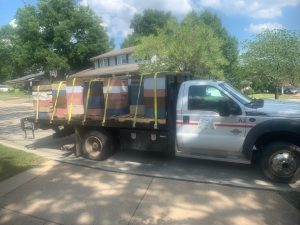
Picture 2. How nice to collect a route of honey in one shot. My bee truck has greatly increased my efficiency by allowing me to make single trips to my outyards.
For space needs, plan for the busiest time of the year and build as big as you can. Even if you have a lot of empty space during most of the year, you will be happy for the space during extractions. Picture 3 shows my building towards the end of my extracting. I had five pallets of supers, some pallets of empties, my extractor and decapping tank, buckets of honey AND I need room for the pallet jack to maneuver. Now add some pallets of sugar, bottles and other equipment and I am at capacity. Far sooner than I expected. You can never have enough shelving. I need space for bottles, a space for clean bottles, a space for filled bottles, a space for lids, a space for buckets of honey, a space for tools, a space for mite treatments and the list goes on. This is beyond the open floor space where you put extra boxes, feeders and supers. Another gem from John Miller, “plan for your first expansion while you are building it.”
Spend the money on the right equipment. The less you have to lift, the longer you can be in the business (i.e. healthy back). I have a pallet jack, dolly and hydraulic cart. All of which help me move things with minimum lifting.
On the electric front. Many circuits, many outlets. Make sure to have overhead outlets. It was wonderful extracting and never stepping on a cord and being able to hose down the floor without worrying about getting the cord wet. I put in a refrigerator, which is necessary for cold drinks and lunches. I also have a stove and microwave.
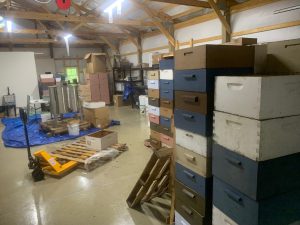
Picture 3. You can never have enough space. Plan for your busiest time of
year and account for the ability to maneuver the pallet jack.
HVAC. I air conditioned the bottling room (16 x 16 kitchen) and I am very glad I did. Missouri Summers are hot and humid and being inside a tin box can get very uncomfortable. Even when not bottling, the bottling room can be refuge from the heat. That being said, a large exhaust fan moves a lot of air in the extracting room. That and two floor fans do a good job in making the room bearable. But, make sure you put a screen around the inside of the exhaust fan. The number of bees that fly into it is amazing. I learned the hard way to make sure your windows are big enough to take an air conditioner. I got 24-inch windows, figuring I just needed them for light. I went to put in an air conditioner to cool things off while extracting and it didn’t fit. Learn from my mistake.
Plumbing. Having an epoxy floor and floor drains make cleaning up a snap. I have both cold and hot water hoses in the extraction room. Hose everything down, squeegee it into the floor drain, then mop it up. The biggest hassle with this is storing the hoses. The slop sink in the extraction room is also a must. I am always covered in honey, now I can wash it off before spreading it all over the place. I also have a bathroom with shower and washer/dryer. I don’t regret any of them. I use the washer/dryer to wash both cleaning rags and my bee suits. It makes the honey house a self-sustaining unit and doesn’t require me to bring anything home.
Find your work-life balance.
We are in this business because we love it. We are building a business because we want to. That situation makes it very tempting to spend all waking hours on your bees and business. Be very cognizant of what you are sacrificing when you go overboard on this endeavor. Your family needs you to be around. You need to maintain your network of friends. Beekeeping is, typically, a solo venture. Where will you get your social interaction? Maintain your piece of mind. It’s great when your hobby can become your career. But if you burn out, you lost both.
 Once upon a time, a young downtrodden beekeeper, Fred, slogged up a mountain to visit a beekeeping monk. He was the wisest monk in the land, or at least that’s what the billboard on the mountain path implied: “IN A FUNK, COME SEE THE MONK—WISEST MONK IN FAIRYTALE LAND!” read the billboard. But the snappy advertising did little to perk up poor Fred. Sadly, Fred felt even more depressed as the path snaked through a forest filled with gnarly old sourwood trees—each tree a reminder of his terrible predicament.
Once upon a time, a young downtrodden beekeeper, Fred, slogged up a mountain to visit a beekeeping monk. He was the wisest monk in the land, or at least that’s what the billboard on the mountain path implied: “IN A FUNK, COME SEE THE MONK—WISEST MONK IN FAIRYTALE LAND!” read the billboard. But the snappy advertising did little to perk up poor Fred. Sadly, Fred felt even more depressed as the path snaked through a forest filled with gnarly old sourwood trees—each tree a reminder of his terrible predicament.
“To beekeep or not to beekeep. That is the question,” Fred thought to himself. Alas, his sweet loving wife, who once encouraged his beekeeping hobby, had recently reversed course and rendered an ultimatum: Either he quits beekeeping for a new hobby that doesn’t involve extracting honey in her newly remodeled cottage kitchen or she quits him and finds a new soulmate. Thus, Fred journeyed to seek wise Brother Yart, a portly old monk whose depth of wisdom was rivaled only by his breadth of waistline. In fact, hood up, in brown monkish attire, Brother Yart resembled a large woodland creature, namely a bear. Which is why Fred shouted “Ye gads, a bear!” upon finally reaching the anchorage and glancing over at the apiary in the backyard.
“Good lord, you nearly scared me to death, sneaking up behind me like that!” said the bear. Of course, a talking bear in Fairytale Land isn’t too far-fetched, but in this case it was no bear, just Brother Yart, who looked like a bear and was working his bees. He was surprised to turn around and see Fred staring at him.
“You nearly scared me to death,” replied Fred. “I thought you were a…”
“…bear—yeah I get that a lot.” said Brother Yart. “What can I do you for? Beekeeping advice, spiritual advice or bulk purchase of sourwood mead? Got a special bundle price this week if you’re interested in all three.”
“Wait, you have to pay for advice?” asked Fred.
“Sure, how do you think I keep up this plush little anchorage. Beekeeping ain’t gonna pay the bills alone.”
“Wait, are you sure you’re the wise old monk that everybody talks about?”
“Yep, that’s me, Brother Yart, wisest monk in Fairytale Land.”
Reluctantly, Fred purchased the beekeeping advice. But Brother Yart, upon hearing Fred’s dilemma, required Fred to buy spiritual advice as well. “Yep,” he said, “anything dealing with soulmates is the spiritual realm.” To Brother Yart’s credit, he gave Fred a thorough advisory session, counseling Fred on life priorities and saying such wise things as, “Son, it’s better to be loved by one woman than to keep the company of many bees, plus divorce lawyers in Fairytale Land are pretty pricey. Last year, Snow White divorced Prince Charming and by the time the lawyers took their cut, Prince Charming was living in his horse-drawn carriage.”
Indeed, the consultation lasted so long that Fred became quite parched and requested refreshment to quench his thirst. Brother Yart obliged and sold Fred many foaming mugs of sourwood mead, after which Fred, possibly impaired from his libations, said,“Yart, buddy ole pal, you’re right, I should donut, ha ha, I said donut, I mean donate my hives to you… then live happily ever after with my wife.”
For a large man, Brother Yart could move fast, and he quickly retrieved his standard donation contract from his filing cabinet and got Fred to sign over all his hives, right before the young man stumbled and passed out.
“Stout stuff. Gets ‘em every time,” chuckled Brother Yart.
Of course, most children think the moral of this fairy tale is to beware of beekeeping gurus because some are sophisticated swindlers. And that would be the moral if the story ended there. But sadly Fred hit his noggin hard after his heavy drinking and thereafter suffered sporadic bouts of amnesia. This explains why, when Fred later saw what appeared to be a bear carrying away one of his hives, he retrieved his shotgun and peppered Brother Yart with birdshot. And this explains why, milliseconds later, Brother Yart dropped the hive on his foot and was instantly enveloped in a cloud of angry bees.
So the true moral of this fairy tale is, “Karma stings.”
Stephen Bishop keeps bees in Shelby, NC. For the record, his wife has not rendered an ultimatum, although honey extraction is now forbidden in his kitchen. You can sign up for his weekly blog post at misfitfarmer.com or follow him on Twitter @TheMisfitFarmer.
]]>I hope that you will like a postcard from my collection entitled The Duet. It shows a fairy princess conducting the music made by a bee on a piccolo and a grasshopper on a violin.
Of course we all know that this could never happen in real life, but did you know that Charles Butler, an English minister, logician, grammarist, musicologist and beekeeper that lived from 1560 to 1647 wrote a book called Feminine Monarchie in 1609? It was revised in 1623 and 1634. There were several errors that he corrected in beekeeping mentioned in his book. One – Aristotle said that the bees in the hive were led by a “King Bee” and Charles Butler identified the bee as the Queen Bee. Two – Butler observed that damaged bees secrete an alarm pheromone which leads other bees to sting. Three – he observed that bees produce beeswax rather than collecting it from plants. Four – he transcribed bee sounds into musical notes. From the tone pitch of the buzzing bees, one might be able to tell when swarming is going to happen. Another tonal discovery was the difference between piping, quacking or tooting. These scores appear on pages 78 to 81 of his 1623 book and are written for four voices: Meane (soprano), Tenor, Bassus and Countertenor. You will find two of them on one side of the page facing each other and the other two parts on the adjoining page so the four singers could be positioned around the book and see their parts.
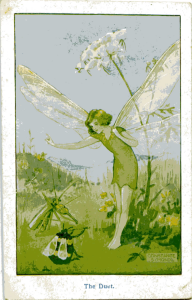 I saw once an account of the difficulties that Butler had in adjusting the tone and frequency of the notes, and was unable to find it again. But he found that it was in the key of G minor or C.
I saw once an account of the difficulties that Butler had in adjusting the tone and frequency of the notes, and was unable to find it again. But he found that it was in the key of G minor or C.
When you think of it, honey bees don’t have a larynx so they have to make noises by using their thorax and wings causing a vibration which can be heard. Oops, honey bees don’t have ears either, so the vibrations are picked up by the fifth segment of their antenna.
When a queen is about ready to emerge from her cell, she makes a noise called piping. A queen that is already in the hive may answer the piping with a sound called quacking or tooting. It is a way for the emerged queen to locate and kill the rival queen while she is in her cell. The beekeeper may look at the queen cells in a hive and tell whether the queen has emerged or was killed. If the queen cell has a trap door open, the queen emerged and if the queen cell has openings along the side of the cell, the queen has been killed.
You may be near the hive and hear the noise of the bees planning to swarm. I don’t remember hearing that sound, but I remember the old saying that when a swarm is in the air, you can get them to land by beating on a pan. Oh, what advice is given! Run in the house and get a pan and something to beat on it, hurry back outside near the swarm, chase after the swarm while beating the pan like crazy, and guess what? The swarm eventually lands. See it works and you had to only travel two blocks.
Bees must think that you understand them. Have you ever stood in the flight path of a honey bee? The first thing that she does is bump into you and you think “What is wrong with these bees, are they blind?” Your second warning is a bee buzzing right in front of your nose and mouth. Why there? Because she has detected that you are alive and breathing by the carbon dioxide that you are exhaling. Now you should step aside for there isn’t a third warning.
Bees communicate with each other by doing such things as a waggle dance and a round dance. These dances tell the other bees where the nectar is in relation to the hive. If you have seen these dances preformed, did you notice the bees close to the dancer are touching her with their antenna?
A study done by Lilach Hadany of Tel Aviv University states that plants hearing the buzzing of the low frequency sound of bees can increase the sugar content of their nectar 12-20%. This increase occurs within three minutes after the buzzing. I wonder if the bee waits until the richer nectar arrives or if it is meant for other bees or creatures. I also didn’t know plants could hear, but I know people talk to their plants. However, I wonder if there are any other studies like this one and how long the rich nectar is viable?
There are studies showing that plants feel pain such as cutting and smashing, but since the plants do not have a central nervous system, they react from vibrations.
There are several others that have used music while working with bees such as Dr. C.C. Miller, George York, Dr. Walter Rothenbuler, Dr. Norman Gary and others.
Dr. Charles C. Miller, June 10, 1831-September 4, 1920, taught singing school while going through school. When he was first married, he taught voice and instrumental music before becoming a high school principal. His fingering procedure on the piano was different from the normal practice, but soon was adapted by many. He teamed up with Eugene Secor of Iowa and wrote many bee songs. These songs were compiled and printed by George W. York as a pamphlet Songs of Beedom. He had an excellent singing voice and sang at the Marengo Opera House between 1883 and 1914. At the International American Bee Keeping Association, he performed a few of his bee songs including “Dot Happy Bee Man” and “The Bee-Keeper’s Reunion Song.”
Dr. Walter C. Rothenbuhler, 1920-2002, and Victor C. Thompson, 1920-2012, were known for the genetics of AFB resistance and hygienic behavior of honey bee stock. When they were teaching at Ohio State University they would occasionally play music to their students.
Dr. Norman Gary served on the University of Davis entomology faculty from 1962-1994. Thus he is known as being a professor, bee research scientist, musician and professional bee wrangler. For more than 65 years he performed in many bands playing clarinet, alto sax, tenor sax or flute. The last group, Beez Kneez, disbanded October 17, 2004.
Most of you know a song that has the word bee in the title as I found fifty of them. But did you know that the song “Flight of the Bumble Bee” ended up as a contest of how fast one could play it?
References:
C C Miller – Wikipedia.pdf
Israeli scientists find a flower they say can hear approaching bees
List of 50+ Songs With Bee in the Title…
The ‘piping’ and ‘quacking’ of queen bees – Moir Rare Book Collections – Nation
What was in the box? Businessmen looked curiously at the large wooden container as they took their seats for the Akron Lions Club meeting.
Soon they were buzzing with excitement.
More than 75 members attended the luncheon 100 years ago at the YWCA at 22 S. High St., a site occupied today by the downtown parking deck for Akron-Summit County Public Library. Founded a year earlier under the principle of “unselfish service to others,” the Akron club welcomed guest speakers each week.
They would not soon forget the lecture of Nov. 15, 1921.
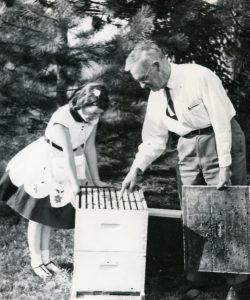
Photo of Huber H. Root
Inventor, author and chemist Huber H. Root, 38, served as general manager of the A.I. Root Co., which his father, Amos, had founded in Medina in 1869. A national expert on bees, H.H. Root had served as an editor and contributor to such publications as Gleanings in Bee Culture, Alexander’s Writings on Practical Bee Culture and The ABC and XYZ of Bee Culture.
He presented lectures across the country and spoke of honey bees with great fervor.
“Bees were not created to make honey,” he told audiences. “They were created to cross-pollinate flowers. The honey making is merely a useful side industry.
Bees do not get honey from the flowers. What they get from the flower is a cane syrup. Through their bodies, this is converted into grape sugar in a mysterious little laboratory that nobody understands.
When a bee is hungry it opens up a little valve from this laboratory into its stomach. When its stomach is full, it shuts off the valve.”
The Akron Lions listened to Root’s presentation with interest. They had all but forgotten about the wooden container until Root motioned to it.
“Now, in this box, I have a beehive and a full swarm of bees,” Root said. “They won’t sting me, of course. But I cannot say what they might do to you.”
Club members laughed.
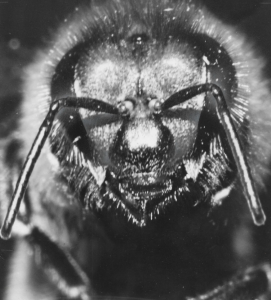
According to A.I. Root Co. Executive Huber H. Root: this un-retouched picture of the head of an Italian honey bee was taken to show the particles of pollen in the hair, thus
dramatizing the bees’ contribution to horticulture.
Beacon Journal File Photo
“You’re joking. Can’t be any bees in that box,” said Dow Harter, founding president, U.S. commissioner and future U.S. congressman.
“We’ll see whether I’m joking,” Root said as he undid the latch and lifted the lid.
An undulating mass of yellow and black teemed inside. As Root pointed out the combs laden with insects and honey, about 40,000 bees were turned loose on the small assembly hall. Pandemonium swept the room as the Lions ducked under tables and covered their heads with tablecloths and napkins.
“Consternation occurred among the club members as the thousands of bees swarmed about them alighting in their hair, on their faces, hands and their clothing,” the Akron Evening Times reported.
“Some, who forgot the admonition of Mr. Root not to slap the bees, and tried to shoo them away, were heard to cry out lustily. A few timid ones, who attempted to make for the door when the insects were released, were deterred by the shouts of their brother members.”
The sound of Root’s muffled laughter cut through the buzzing. When the Lions finally dared to look up, they were amazed to see that Root was covered in bees.
He carefully shook off the insects, put them back in the hive and fastened the lid.
“A bee can’t sting unless he sits down,” Root said. “And my bees are all trained to stand up.”
The Lions chuckled as they returned to their seats, amazed by the startling demonstration.
While the Beacon Journal reported that no club members had been stung, the Evening Times mentioned a “few casualties,” but noted that there wouldn’t be “many downtown businessmen who will go home to their wives this evening nursing a swollen jaw, eye or something else.”
Explaining the inner workings of a hive, Root said the bee colony “is the only real social colony in the world.”
“Nobody gives orders in a bee community,” Root said. “There is no division of labor. If a bee sees there is work to be done, it goes and does it.”
Contrary to popular belief, he said, the queen is not the ruler of the colony but is subservient to the wish of the workers who exert total control.
The workers are not neuters but immature females, he said, and queens are mature females. The queen’s job is to lay eggs. If the workers want more eggs, they feed the queen more, Root said. If the workers want fewer eggs, they feed her less.
A queen will lay two and a half times her weight in eggs every 24 hours, Root noted. She eats two and a half times her weight every day. And there can only be one. Two queens will fight to the death.
“The drones have been maligned a great deal for being lazy,” he said. “That is unjust. Nature has not equipped the drones with tongues and stings so that they can work. When there is plenty of honey, the drones are tolerated. When the food supply runs low, the drones are thrown out to starve.”
The Lions probably learned more about bees that day than they ever expected. The incident made national headlines.
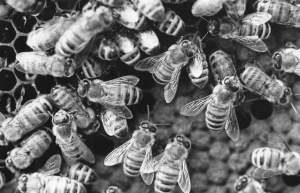
National bee expert Huber H. Root called bees “the only real social colony in the world.”
Beacon Journal File Photo
Bee allergies must not have been a common concern 100 years ago, because Root pulled the same stunt at lectures across Ohio. Several months later, he gave a talk at West High School in Akron.
“What sort of institution do you think this would be if every individual thought only of bettering the high school?” Root told students. “Suppose nobody thought anything of self-advancement. Suppose a school where the community spirit was 100 percent.”
Students shouted and shrieked as Root opened the hive and let 40,000 bees loose. He told the children not to panic.
“Bees don’t like nervous people, but it is hard to get them to sting in self-defense,” Root said. “They reserve their stings for the defense of the hive.”
The bees returned to the box. No stings were reported.
Root repeated the stunt that week at Central, North and South high schools.
We live in a different world than a century ago. Try to imagine school officials allowing such a demonstration today.
H.H. Root went on to serve as president and chairman of the A.I. Root Co. Board. He introduced rolled beeswax candles, which were more resistant to heat, and invented a glass-encased sanctuary light that kept wax from dripping in churches.
He also wrote the 1951 textbook Beeswax, Its Properties, Testing, Production and Applications.
Root was 88 years old when he died in 1972.
The A.I. Root Co. celebrated its 150th anniversary in 2019. The fifth-generation, family-owned business, which continues to call Medina home, produces about 20 million candles a year and touts its products as “The Best Candles in America.”
The company has been generating a buzz since 1869.
But don’t worry: It no longer releases 40,000 bees at public meetings.
Mark J. Price can be reached at [email protected].
]]>Click Here if you listened. We’re trying to gauge interest so only one question is required; however, there is a spot for feedback!
Read along below!
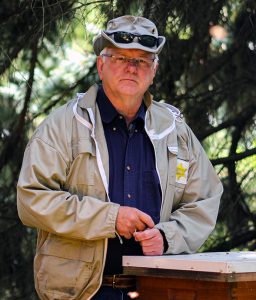 Honey Bee Husbandry in Plastic Hives
Honey Bee Husbandry in Plastic Hives
Surprisingly, beekeepers have a long plastic hive history.
By: James E. Tew
It seems to me
We all have our reasons that determine what we house our bees in. Our ancestors used box hives and the occasional skep. In all my bee life, I have primarily used ten-frame, wooden equipment. I use that kind of equipment simply because I have always used it. Some of you use eight-frame equipment. Others are eager to use top bar hives or other such related styles.
Many of you even use various types of plastic hives that are offered in multiple sizes and chemical configurations. Plastic bee hives – in one form or another – have been presented in supply catalogs at least since the late 1960’s. Honestly, plastic hives cannot really even be called a new idea.
Wood and wax
I’ve always been a wood guy. The odor of new pine wood blended with the smell of beeswax has always pervaded my beekeeping life. As the years have passed, increasingly, that smell always took me to beekeeping. Even now, the smell of newly milled pine brings back pleasant memories of new wooden bee equipment. And, of course, the odor of beeswax and combs is the classic aromas of bees’ world. These blended odors are the very essence of olfactory beekeeping.
Ironic to admit to you that I have been a woodworker longer than I have been a beekeeper. So, If I am so committed to woodworking, and spent several years building all my hive parts, why do I have any interest in plastic bee hives? Short answer – I really don’t know, but please don’t stop reading yet. I think I can explain.
Readers, this is not a comprehensive history piece…
While I believe that a thorough review of the decades-long plastic displacement of nearly everything wooden or metal in beekeeping would be interesting, that endeavor is beyond my ability and certainly beyond my space limitations here in Bee Culture. In this article, I will only be referring to plastic beekeeping events that have influenced me personally, and in fact, continue to affect me to the present time.
The Walter T. Kelley Bee Supply Company and plastic hives
I mean no omission to any manufacturer, but in my early bee life, the big three bee supply companies were: Dadant and Sons, The A.I. Root Company, and the Walter T. Kelley Company[1]. Shortly after beginning beekeeping in 1972, I realized that the Kelley Company was offering single-piece, plastic inner covers, outer covers, and bottom boards. This equipment was touted as rot-proof and maintenance-free. In 1975, three years later, Kelley added plastic hive bodies in two depths.
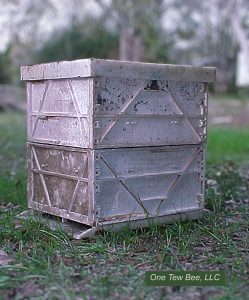
Figure 1
An old, soiled Kelley Plastic Hive, circa 1980.
There it was – a bee hive made entirely of plastic[2]. How modern! While I was dedicated to woodenware, this prominent supply company was seriously delving into plastic rather than wood as hive building materials. Though the Kelley Company maintained its wooden hive production capabilities, it was intriguing that heavy-duty, plastic hive equipment was also offered. This was a major bee supply company manufacturing plastic equipment and I admit that I was influenced by their plastic inventory offerings.
I recently spoke with a Kelley representative
A long time representative of the Kelley Company said that all the plastic hive components were manufactured for many years by several different plastic molding companies in Indiana and Arkansas. The sole piece that remains in production today is the outer cover. After so many years, why did this kind of equipment phase out of their catalog?
Through the years, the plastic molds aged and began to show wear, production companies changed, and beekeeper interest in this style of hive waned. Over time, the hard plastic hive components were dropped from the catalog.
My experience with the Kelley plastic hives was more positive than negative. Yes, the hive equipment did not “breathe” and needed more winter ventilation. Some of the pieces such as the inner cover, would slightly bow at the hand-hold spot in the middle of the inner cover. Later models of the plastic inner cover had support points to address this issue. Bottom boards also deflected some, but that issue, too, was rectified.
The equipment was rugged and weighed about the same as a comparable wooden hive body. The plastic equipment did not require painting and was wax moth and termite resistant. Since the frames were generally made from wood and beeswax, it seems to me that the bees readily accepted the plastic hive body components. Lastly, as I recall, the selling price was similar, too.
As I write this, I wonder if this plastic equipment – or any plastic equipment for that matter – could be sterilized if American foulbrood was found? I can’t answer my own question. Certainly, plastic could not be scorched with fire as has been done with wooden equipment.
My alarms are sounding
This article is not developing along the pathways I anticipated. I have mental alarms going off. Increasingly, in this piece, I am flirting with the concept of providing reviews for plastic equipment use in my apiary. That is not my intent, but how do I describe one product that I own and not mention the others that I also use? So here I am – getting in deeper and deeper as I write about plastic bee hives.
Other plastic equipment in my apiary
I presently have – and use – plastic hive components from Mother Lode, Beaver Plastics, and Bees Forever.
Mother Lode Products[3]
I have used a couple of UV Stabilized Polypropylene hive bodies from Mother Lode Products for several decades. What can I say? My pieces of this equipment have sat outside without maintenance or paint for all those years. The hive bodies have been consistently rugged and stable. The bees seem okay with them, and wax moth and carpenter ants have not been a factor.
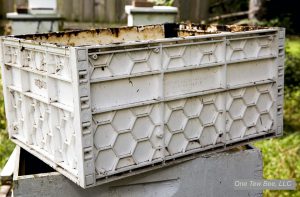
Figure 2
A decades-old Mother Lode plastic hive body.
The R-Value insulation rating simply has to be low. The plastic is nearly translucent at its thinnest points. To compensate, on their web page, the company refers to insulating panels for winter use, but I have no experience with that equipment. I post no recommendations, but after all these years, I have no complaints with my pieces of this equipment.
Beaver Plastics and Bees Forever
Two other types of equipment that have been in my apiary for many years are from Beaver Plastics [4] and Bees Forever[5]. The Beaver Plastics design is thick polystyrene, while the Bees Forever design, like the Mother Lode Products is hard plastic.
Both products are produced as a single piece molded plastic. That design generally increases shipping costs, but there is no assembly time required. The Mother Lode equipment was shipped flat so it required simple assembly.
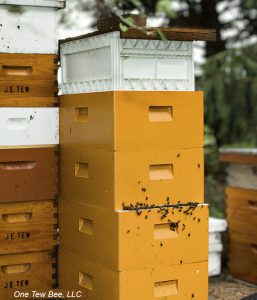
Figure 3
Two types of plastic bee equipment on the same colony (Bees Forever on top and Beaver Plastics on bottom).
Bee Max and Lyson polystyrene hive equipment
Bee Max[6] and Lyson[7] are both manufacturers of plastic bee hive systems. I do not have experience with either of them, but they are both readily available in the bee industry.
Readers, plastic equipment supplies, and abundant styles are available worldwide. Earlier in this article, I indicated that my alarms were sounding. That is still the case. With so many options and so many suppliers, I will most likely get something wrong here. The reader will have to talk to beekeeping friends and peruse the beekeeping equipment internet to make a final decision on this subject.
Bee Box[8] from Paradise Honey
I wish I could write that I had specific reasons, but honestly, I purchased enough equipment for two hives and a queen mating nucleus hive manufactured by Bee Box from Paradise Honey for mundane reasons. I made the decision to purchase this particular model simply because it was available at the moment, I had my truck with me, I had decided to purchase some polystyrene equipment, and the company would take a credit card. After several seasons of use, all has gone (mostly) well. I have used this equipment for several seasons and am comfortable providing the following conversational points.
Applying glue to joints is required
Though this unit was easy to assemble, glue must be used at the time of assembly. The same glue used to assemble wooden equipment is appropriate for assembly of this thick polystyrene equipment.

Figure 4
A cracked joint. My fault. I should have applied glue at the time of assembly.
I was eager to get bees in some of my new-fangled equipment so, without gluing, I snapped one deep together and got a colony established in it. As time passed, the joints on that unglued deep opened a bit, and the bees quickly filled those crevices with propolis. Now it will be difficult – short of complete disassembly – to make needed changes and correctly apply the glue. My lesson learned – apply glue at the time of assembly.
Painting
After assembly, I used my small airless spray paint equipment. Brushing the latex paint on would certainly have been fine, but I had the spray equipment, and it was faster than brushing. I applied two coats. On the hive bodies and supers, I taped off the contact points where the hive tool will be used. I did this not because it was necessary, but primarily because it made the final paint job looked nicer.
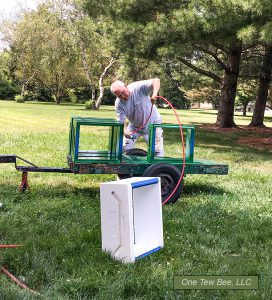
Figure 5
Painting polystyrene hive bodies with latex paint. Note blue tape application.
After beginning to use the equipment, I had problems with the paint sticking to mated surfaces of the hive bodies. I sense that this was a paint issue more than an equipment issue. I waited a couple days before using the newly painted boxes, but they still stuck together and pulled some of the paint off when I later separated the boxes. What to do the next time? Possibly coat the broad painted edges with beeswax or simply do not paint the edges at all. Any suggestions?
Hive tool use
Hive tool use must be modified – particularly when removing outside frames. If I used my hive tool to pry out a frame near the side wall, I could unintentionally put pressure on the glued corner joint. Traditional wooden equipment could easily withstand this corner stress, but when using polystyrene, more care is required. In fact, I did break a joint that connected the front with the side. I referred to this incident above.
Maybe I should have used more glue to strengthen the joints, but what I have been doing that works very well is to use a “frame Grip.” First, I break the frame free. Then using the grip with hive took assisting as needed, I remove the first frame.
Overall, when handling a full deep of bees and honey, I had a sense that this box would not withstand rough treatment or being “racked” by stressing the load on the corners. Just knowing this is enough to handle a full polystyrene box differently than I would handle a wooded deep hive body.
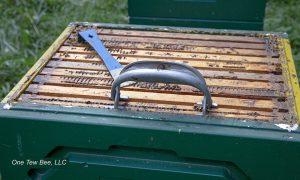
Figure 6
A frame grip and a hive tool used to remove frames. The hive tool can only be used at yellow surfaces. Note some of the green paint pulled off at the corners.
Bees and animals gnawing
I knew that under some conditions, bees will gnaw and chew the polystyrene surface and corners. To help forestall this potential problem, I chose to paint the inside of my equipment with latex paint. Others may not want to paint the inside and I understand that. Paint the inside or not – that will be your call.
Even so, most likely at some point bees and or animals are going to have a chew on this plastic. But chewing animals will also chew on wooden equipment. I consider animals chewing the equipment just to be routine “wear and tear” but what about the bees occasionally gnawing on the equipment? I have wondered if coating the inside of the polystyrene equipment with beeswax would help? (Straight up – let me say that I really doubt that I will ever try that. Too much work. If you do, I hope you will let me know how it worked out.)
Of course, under failed conditions, wax moths will chew up anything. No surprises there, but I did have some unexpected challenges having carpenter ants that constructed nests inside the thick walls of the bee boxes. They were not difficult to shake out, but the equipment was blemished by their activity.
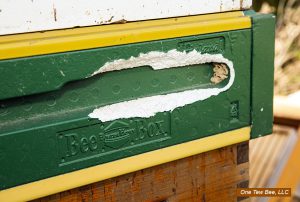
Figure 7
Animals gnawing on plastic equipment. Squirrels?
The good points
Insulation – no doubt about it. The thick walls insulate the sides and ends of the hive. To an extent, both the bottom and the top are insulated, too. Brood may be put in combs along the side wall if the colony is populous, and the brood nest is crowded. This nearly ever happens in simple wooded hive bodies.
I cannot yet say that it was wildly helpful during winter, but all other things being equal, I would expect the insulation effect to be significantly helpful. Adequate ventilation is important.
The equipment fits together nicely and, at least with the equipment I am using, I can readily interchange wooden equipment with the plastic equipment. The equipment has a snug fit and once propolis is added, the unit becomes a firmly meshed hive.
Once painted and cured, the equipment requires few concerns. A positive point with no other real place to post it is that the top feeder, once painted and installed fits snugly and is water tight without any seepage. A top feeder is shown on the polystyrene hive in the photo.
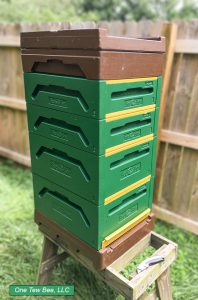
Figure 8
A polystyrene hive with a top feeder.
So, now what?
Should I use plastic equipment, or should I never use it? As is so often the case in beekeeping, the answer to that question is purely your call. I explained why I have primarily used wooden hive equipment, but the plastic equipment experience adds variety to my apiary. I like the diversity, but I truly like the smell of freshly milled pine, too.
I always appreciate you reading, thinking, and communicating with me on these subjects. It’s how we all grow. Thank you.
A bit of a discussion on this plastic hive subject
There is a discussion on pros and cons of plastic equipment, albeit a bit dated, at: https://www.beesource.com/threads/advantages-and-disadvantages-of-polystyrene-hives.320176/

Dr. James E. Tew
Emeritus Faculty, Entomology
The Ohio State University
[email protected]
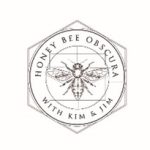 Co-Host, Honey Bee Obscura Podcast
Co-Host, Honey Bee Obscura Podcast
www.honeybeeobscura.com
Footnotes
[1] The Walter T. Kelley Company is now affiliated with Mann Lake Bee and Ag Supply, https://www.mannlakeltd.com/catalog/ [2] At that time, the frames were still wood, and the foundation was beeswax sheets. Frames and foundation were not made from plastic. [3] Mother Lode Products. https://www.motherlodeproducts.com/ [4] Beaver Plastics. https://workerandhive.com/products/beaver-plastics-polystyrene-brood-box [5] Bees Forever. https://www.facebook.com/people/Bees-Forever-Plastics/100066450133863/ [6] Betterbee. https://www.betterbee.com/beemax-hive-kits/blk1-beemax-light-weight-kit.asp [7] Lyson. http://lyson.eu/ule-styropianowe/5444-amercian-langstroth-bee-hive-8-frames-roof-2-x-body-bottom-not-painted.html [8] Blue Sky Bee Supply. https://blueskybeesupply.com/hive-components/polystyrene-hives-components/ ]]>Click Here if you listened. We’re trying to gauge interest so only one question is required; however, there is a spot for feedback!
Read along below!
Found in Translation
I’ve just gotta bee me!
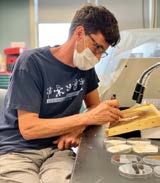 By: Jay Evans, USDA Beltsville Bee Lab
By: Jay Evans, USDA Beltsville Bee Lab
Picture peeping into an observation hive or simply watching a pulled frame of calm worker bees. You will soon notice a range of different acts by the bees in your view. Some might be burrowed into cells, some will be engaged in intimate conversations with nestmates, some will be carrying hive debris and some will be doing a happy dance after bringing back pollen or nectar. It has been known for decades that worker bees advance through different tasks as they mature. The primary shift is from ‘nursing’ or nest behaviors while bees are young, to foraging behaviors as they grow older. Young bees produce a nutritious processed food that they use to provision brood, and younger bees also produce the wax needed for hive partitions. Older bees, typically around two weeks old, start a life of foraging when outside conditions permit. If you want to read more about life’s big changes among social insect workers, including this switch from indoor to outdoor tasks, read the review article Regulation Of Division Of Labor In Insect Societies by Professor Gene Robinson (https://www.researchgate.net/profile/Gene-Robinson/publication/21615667_Regulation_Of_Division_Of_Labor_In_Insect_Societies/links/5738cf9a08ae9f741b2bd8a1/Regulation-Of-Division-Of-Labor-In-Insect-Societies.pdf), a review which has held up well since being published 30 years ago.
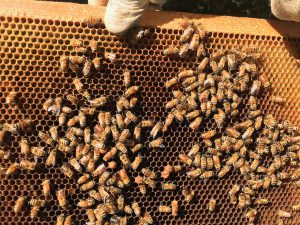 But these major transitions are not the whole story. Gazing into our lab’s observation hive makes me think of the picture books by Richard Scarry I read while young (you can’t go wrong with his book What do people do all day?). In these books, everyone is shown doing a specific trade, reflecting the many workers needed to make societies function. Bees are onto that as well, by specializing to some extent on certain hive roles. The specialization is subtle in the face of typical life transitions. Most bees, if they live long enough, will fly from the hive as they mature and initiate foraging. Similarly, most young bees will do some nursing. But there are deviations from this path. Some bees are known to be ‘precocious’ foragers, perhaps reflecting a stress faced earlier in their lives or perhaps reflecting their particular genetics. While foraging, some bees might prefer pollen to nectar on their floral trips, while others might tend to favor resins from plants, or water. In the nest, some bees are better linked into the social web than others and some might linger on particular observable tasks. In short, a bee is a bee; a replaceable but non-identical part of the whole colony.
But these major transitions are not the whole story. Gazing into our lab’s observation hive makes me think of the picture books by Richard Scarry I read while young (you can’t go wrong with his book What do people do all day?). In these books, everyone is shown doing a specific trade, reflecting the many workers needed to make societies function. Bees are onto that as well, by specializing to some extent on certain hive roles. The specialization is subtle in the face of typical life transitions. Most bees, if they live long enough, will fly from the hive as they mature and initiate foraging. Similarly, most young bees will do some nursing. But there are deviations from this path. Some bees are known to be ‘precocious’ foragers, perhaps reflecting a stress faced earlier in their lives or perhaps reflecting their particular genetics. While foraging, some bees might prefer pollen to nectar on their floral trips, while others might tend to favor resins from plants, or water. In the nest, some bees are better linked into the social web than others and some might linger on particular observable tasks. In short, a bee is a bee; a replaceable but non-identical part of the whole colony.
Recent technical advances allow researchers to both measure and analyze the behaviors of bees throughout their lifespans and in a social setting. Numbered tags, similar to those put on some queens, have been used to keep track of individual worker bees for decades. Newer tags are both more ‘apparent’ to hive sensors and have a far greater level of discrimination, allowing hundreds or thousands of bees to be followed at once. Professor Robinson’s group has deployed this technology to tackle bee health issues ranging from the impacts of infection and chemical stress on bee behavior to a better understanding of the underlying neurodiversity of bees and how this diversity is driven by age and genetics. One example of this line of work comes from a paper with Tim Gernat as lead author (Gernat T, Rao VD, Middendorf M, Dankowicz H, Goldenfeld N, Robinson GE (2018) Automated monitoring of behavior reveals bursty interaction patterns and rapid spreading dynamics in honeybee social networks Proc Natl Acad Sci 115:1433–1438. doi:10.1073/pnas.1713568115). My favorite insight from this paper was that bees did not inherently recognize each other as individuals, and therefore bee-to-bee feeding was driven by chance encounters and immediate cues, rather than some shared memory of prior encounters. The paper is highly technical, in part because the authors want the results to be general to all society interactions, including our own. It is also impossible to analyze so many interactions without classifying each encounter in a strict mathematical way.
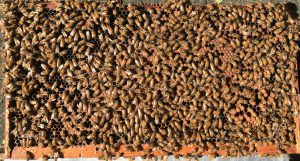 If that paper catches your interest, you will also enjoy an upcoming paper that tackles individual bee biases (‘personality’ is probably too strong of a word) that can last throughout their lifetimes. This paper, led by Michael Smith from Auburn University (Smith, M. L., Davidson, J. D., Wild, B., Dormagen, D. M., Landgraf, T., & Couzin, I. D. (2022) Behavioral variation across the days and lives of honey bees. iScience, 104842. https://doi.org/10.1016/j.isci.2022.104842) ups the bee-tracking challenge by following over 4,000 nestmates as they do their nest duties over an entire Summer. The results are complex and could be scrutinized for months, but there are some interesting guilds or ‘clusters’ of bees that seem to be on more similar paths than the paths of others. These paths involve the aforementioned age-biased tendencies to leave the nest and fly. Within that split, some groups of bees might be more prone to navigate widely in the nest than others, or to be found hovering around honey stores. And I especially resonated with ‘day cluster 4’ (“behavioral days associated with middle-aged bees, with metrics representing slow, localized behavior”). That sounds a lot like the past two years for me.
If that paper catches your interest, you will also enjoy an upcoming paper that tackles individual bee biases (‘personality’ is probably too strong of a word) that can last throughout their lifetimes. This paper, led by Michael Smith from Auburn University (Smith, M. L., Davidson, J. D., Wild, B., Dormagen, D. M., Landgraf, T., & Couzin, I. D. (2022) Behavioral variation across the days and lives of honey bees. iScience, 104842. https://doi.org/10.1016/j.isci.2022.104842) ups the bee-tracking challenge by following over 4,000 nestmates as they do their nest duties over an entire Summer. The results are complex and could be scrutinized for months, but there are some interesting guilds or ‘clusters’ of bees that seem to be on more similar paths than the paths of others. These paths involve the aforementioned age-biased tendencies to leave the nest and fly. Within that split, some groups of bees might be more prone to navigate widely in the nest than others, or to be found hovering around honey stores. And I especially resonated with ‘day cluster 4’ (“behavioral days associated with middle-aged bees, with metrics representing slow, localized behavior”). That sounds a lot like the past two years for me.
When one looks at the ‘lifetime achievement’ of individual bees, there are bees that moved to foraging earlier than others (and died younger) but also bees that tended to be more mobile in the nest, and show traits that set them apart from other nestmate groups. In short, whether defined by five clusters (as in this study for bee-days and bee-lives) or three or 20 clusters, there is solid evidence that bees don’t all follow the same life journey. It will be fascinating to connect these behavioral quirks with bee genetics (reflecting the dozens of possible paternal lineages in each colony), pesticide exposure, or maybe just a chance encounter of some sort earlier in life that has long-term impacts on bee lives. Honey bees have faced a lot of scrutiny by beekeepers and scientists, but one of the last frontiers is to see how individual members of the colony superorganism deviate enough from the lockstep of colony life to make things perhaps a bit more stable, if not more efficient. It takes a colony to raise a bee, but that bee then has some flexibility in her choices as she navigates cues and events both within and outside her home.
]]>Click Here if you listened. We’re trying to gauge interest so only one question is required; however, there is a spot for feedback!
Read along below!
News Notes

By: Ross Conrad
Vermont first state to allow oxalic acid extended release mite treatment
A novel approach to control varroa mites is gaining attention around the U.S. that utilizes oxalic acid (OA) extended release (OAE). The first article on OAE appeared in the journal Apidologie (Maggi et al., 2015) and described a combination of OA and glycerin that showed effectiveness against Varroa for over 40 days after introduction to the hive. Randy Oliver of scientificbeekeeping.com has conducted additional trials on OAE but unfortunately this novel approach to varroa control has not yet been approved by the Environmental Protection Agency (EPA).

A new extended release oxalic acid treatment shows great promise in the effort to control varroa.
Generally, it is a violation of federal law to use a pesticide, or cause a pesticide to be used in ways that are inconsistent with its label. Exceptions to this regulation are found in the Federal statute that governs the registration, distribution, sale and use of pesticides known as the Federal Insecticide, Fungicide and Rodenticide Act (FIFRA). Exemptions are found in FIFRA 2(ee) (1-4) which describe the four special circumstances in which it (a pesticide) is permissible for a pesticide to be used in a manner which is not specifically labeled.
In May of 2022, the state of Vermont became the first state in the U.S. to authorize a 2EE exemption for the use of a method for controlling varroa mites through the application of oxalic acid that is not allowed by the label, but is not specifically prohibited by the labeling. The state-wide label exemption to allow the use of oxalic acid sold under the brand name Api-bioxal using an extended release formulation for mite control is expected to assist Vermont’s beekeepers who have been struggling with the latest dramatic increase in annual colony losses that began around 2007.
So far, beekeepers who have experimented with OAE are reporting very good control of varroa and find the extended release oxalic acid formulation greatly decreases Winter colony losses, is gentler on the bees than many other treatments, is safer for beekeepers than many other treatments and eliminates concerns over contamination of honey or wax from the treatment’s active ingredients.
Unfortunately it may not be possible for all states to implement a 2EE exemption for OAE. Ideally, the registrant of Api-bioxal will amend their label language with the EPA to include this slow release method of applying oxalic acid so it would become available to beekeepers in all states.
EPA ignores own standards when evaluating cancer risks
On July 20, 2022 the EPA Office of Inspector General (OIG) issued a report that found the EPA failed to follow standard operating procedures and requirements in its pesticide cancer risk assessment process.

The U.S. Environmental Protection Agency has repeatedly failed to protect human and environmental health in their approval of toxic chemicals for use in agriculture.
The report comes on the heels of a U.S. Court of Appeals decision that overturned the EPA ruling that glyphosate, the active ingredient in Roundup, is safe for humans and wildlife. Not only did the court rule that the EPA’s “inconsistent reasoning” made its decision on cancer “arbitrary,” the court found the EPA violated the Endangered Species Act since the agency had previously admitted that “glyphosate ‘may affect’ all listed species experiencing glyphosate exposure—that’s 1,795 endangered or threatened species,” but ignored the Endangered Species Act in its decision.
Montsanto-Bayer’s glyphosate based pesticide is the most widely used pesticide in the world and numerous studies have found potential links to adverse honey bee impacts. (Balbuena et al., 2015; Faita et al., 2018; Herbert et al., 2014; Motta et al., 2018)
The failure of the EPA to adequately evaluate pesticides safety should cause those who still have confidence in the EPA to protect honey bees and other pollinators from non-target pesticide exposures and their impacts to rethink their misplaced confidence.
Environmentally: honey is better than sugar
Honey is largely considered the first sweetener used by mankind. It is the only sweetener we use that does not require processing for it to be usable. Today, there are numerous sweeteners that compete with honey for the consumers’ attention and dollars. Sucrose which is composed of 50 percent glucose and 50 percent fructose is the most common sugar. It is often called table sugar and is usually extracted from sugar cane and sugar beets.
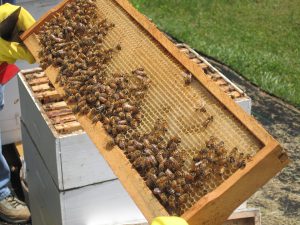
Honey bees do the lion’s share of the work to produce honey, making the golden sweetener the number one choice for the environmentally conscious.
Sugar is also found everywhere. Not only is it found in foods as a main ingredient such as cakes, pies, ice cream, cookies and candy bars, but it is often added to foods that do not naturally contain sugar, such as luncheon meats, baby foods, soups, canned vegetables, cereals and most convenience foods like frozen TV dinners. Sugar is pervasive and its sweet taste is universally enjoyed. Unfortunately, sugar production is also quite harmful to the environment. A July article titled Sugar Taxation for Climate and Sustainability Goals (King & van den Bergh 2022) suggests that reducing sugar consumption could help fight climate change, reduce environmental damage from sugar mill pollutants and help prevent the loss of biodiversity.
The sugar mills that process sugar cane consume large amounts of energy and the majority of the time that energy is produced by fossil fuels. Honey on the other hand is produced be bees whose energy requirements are fueled by the nectar of flower blossoms. Any fossil fuels used to produce and process honey is limited to the occasional trips the beekeeper makes to check on the bees during the season, the energy used to extract the honey and the embodied energy that goes into making the hive equipment used to house the bees. As a result, not only is local honey the least environmentally harmful sweetener, but it has one of the smallest carbon footprints of all foods.
In addition, the wastewater runoff from sugar cane fields, sludge washed from mills and plant matter waste produced as a result of sugar production choke bodies of fresh water, absorbing available oxygen and lead to massive fish die offs. In contrast, the only waste produced during honey production is beeswax which can be rendered, cleaned and is a valuable resource used to produce additional products.
Meanwhile, plant and animal habitat is destroyed when fields are created to facilitate sugarcane cultivation which significantly increases biodiversity loss. As honey bees go about collecting nectar to produce honey, the impact that pollination produces helps to maintain biodiversity. The authors of the Nature Sustainability study hint that taxing sugar would be a good way to reduce its consumption but do not suggest how people might replace this ubiquitous sweetener. We beekeepers have the answer: everyone who uses sweeteners should substitute honey for sugar whenever possible.
References:
Balbuena, M.S, Tison, L, Hahn. M.L, Greggers, U, Menzel, R, Farina. W.M., Effects of Sublethal doses of glyphosate on honey bee navigation, Journal of Experimental Biology (2015) 218: 2799-2805; doi: 10.1242/jeb.117291
EPA Office of Inspector General (2022) Hotline Report: Ensuring the safety of chemicals, The EPA needs to improve the transparency of its cancer-assessment process for pesticides, Report No. 22-E-0053
Faita, M. R., Oliveira, E. M., Alves Junior, V. V., Orth, A. I., Nodari, R. O. (2018) Changes in hypopharyngeal glands of nurse bees (Apis mellifera) induced by pollen-containing sublethal doses of the herbicide Roundup, Chemosphere, Vol 211 pp. 566-572
Herbert, L.T, Vázquez, D.E., Arenas, A., Farina, W.M, Effects of field-realistic doses of glyphosate on honeybee appetitive behaviour, Journal of Experimental Biology (2014) 217: 3457-3464; doi: 10.1242/jeb.109520
King, Louis, C. & Jeroen van den Bergh (2022) Sugar taxation for climate and sustainability goals, Nature Sustainability
Maggi, M., Tourn, E., Negri, P., Szawarski, N., Marconi, A., Gallez, L., Medici, S., Ruffinengo, S., Brasesco, C., DeFuedis, L., Quintana, S., Sammataro, D., Eguaras, M. (2015) A new formulation of oxalic acid for Varroa destructor control applied in Apis mellifera colonies in the presence of brood, Apidologie 47
Motta, E.V.S., Raymann, K., Moran, N.A. (2018) Glyphosate perturbs the gut microbiota of honey bees, Applied Biological Sciences, 115(42): 10305-10310
US Court of Appeals for the Ninth Circuit (2022) Case No. 20-70787 https://www.centerforfoodsafety.org/files/ca9_glyphosate-decision_82995.pdf
By: Richard Wahl
My First Season
I have to admit that after a fellow beekeeper assisted me in catching my first swarm thirteen years ago, I had no idea what I was getting into. How hard could it be, right? Put some bees in a box and maybe get some honey in a year or two. I soon found this was a far too simplistic idea that I think too many first time beekeepers start with. After a bit of research on the internet, which had far fewer reliable sources thirteen years ago, I managed to cobble enough information together to get me through that first Summer and the following Winter. At the time, I knew nothing about mites but did treat once in late October with Check-Mite strips after reading on the internet about the potential mite problem. I went into Winter after that late June swarm catch with my newly caught charges occupying two, ten frame deeps, no insulation and no early Winter feeding; they were on their own. Researching a bit more from internet sources, I made my first candy board late that Winter and learned a few lessons with that process along the way. I placed the candy board on the hive in mid-February and that was enough to keep them alive into Spring when that hive and a second hive from an early purchased package did provide some honey in my second year. From that inauspicious beginning I increased my hive count each year with a few splits and additional package purchases also often losing a few each Winter. Over the following years, I made mistakes along the way and continued to learn and refine my techniques while getting at least one hive through each Winter with one to four hives through the next five or six Summers. After ten years of trial and error, I have come up with a winterization system that seems to work for me.
Start Preparing in Summer
The first key component of preparing for Winter is to keep your mite counts under control during the previous Summer. If my mite count tests dictate a need for treatment, I like to treat with Formic-Pro in late June or early July and again in late August or early September. Here in SE Michigan a 1% count in Spring and 3% count in Fall are generally accepted as the point at which a treatment is recommended. There are a variety of treatment options on the market that other beekeepers favor, but I can only relate to what has worked the best for me. Using either the powdered sugar or alcohol wash test provides a fairly accurate mite count. Collecting a half cup of bees for either test method is approximately 300 bees, so divide the mites found as a result of either test by three to get a percentage. Anything over three mites in Spring would reach the 1% threshold while anything over nine mites in Fall would reach the 3% threshold. As the queen starts to be shut down in the Fall, the brood chamber begins to be back filled with nectar, which may become capped honey. Just as the queen begins to lay fewer eggs, which will become the overwintering bees, the mites will be increasing their reproduction rate to take advantage of those larval bees that are building up increased fat stores to get them through Winter. This can lead to a mite population explosion if some intervention is not taken by the beekeeper. No Summer treatment for mites or a heavy mite count in late Fall seems the most likely greatest reason for loss of hives over the Winter in our area.
Another treatment I use is the oxalic acid dribble as late in the Fall or early Winter as possible. While the formic treatment will penetrate under capped cells, the oxalic acid vapors or dribble will not and therefore will not reach those mites under capped cells. That is why the oxalic treatment is used as late as possible when very little capped brood is present. I will get to the specifics of an oxalic dribble near the end of this article. But before the time for the oxalic dribble occurs, feeding your bees in the Fall will also assist in a strong population more likely to get your hive through Winter. In the Fall, any of the feeding systems using two to one sugar syrup by weight or volume will help the new Fall emerging brood build up body fat. So, as soon as honey supers are no longer on the hives, I will add a liquid sugar syrup feeder to my hives. These are usually inside top feeders or inverted buckets over the inner cover hole surrounded by an empty super box. These stay refilled while Fall/early Winter temperatures stay above freezing. If there is a warm week, the bees can easily go through a gallon of sugar syrup if there is no Fall nectar flow going on.
When Temperatures Drop
I normally take each of the actions below at the same time, once temperatures are consistently forecast to drop below freezing at night. The first is a switch to a candy board or granulated sugar feed. In my first half dozen years of beekeeping I used candy boards. This is where about five pounds of sugar is dissolved in a cup of water and brought to a rolling boil where the dissolved solution will normally turn clear at the 260°F (127°C) to 270°F (132°C) range while stirring constantly. At this point, when allowed to cool to about 180°F (82°C) and poured into a form, it should solidify to a hard candy state. This hard candy board is set on the hive, candy side down, for the bees to use as a food source over Winter as needed. As an aside, I once assisted a new beekeeper one Spring. She had her son place the candy board on the hive that previous Fall, which he did with the candy side up. It was an honest mistake; the bees failed to come up through the center hole and never touched the sugar candy resulting in the loss of the hive.
Since those first years, I have come up with an easier method that also seems more beneficial to the bees. I staple a one-half inch square piece of hardware wire mesh, often called one-half inch hardware cloth, to a three inch deep super spacer and lay a piece of baking parchment paper on the wire mesh. Several knife slits in the paper give the bees a starting point to chew through to reach the four to five pounds of granulated sugar poured on top of the paper, if it is needed as an additional food source. In addition to providing a supplemental food source, the granulated sugar also absorbs moisture which would otherwise condense and fall back on the bees. Bees can tolerate the cold but cannot tolerate being wet and cold. The first year or two with this method I simply used newspaper. I found that the bees can easily chew through most of the newspaper and much of the sugar falls to the bottom board. With the baking parchment paper they tend to chew through one or two spots and work out from those spots wasting less of the sugar falling to the bottom of the hive. Any moisture hardened sugar can be collected in Spring and reused the following Winter.
Another thing I have found to be useful is a one inch thick piece of foam insulation that just fits inside the outer cover. For several years, I removed this outer cover insulation piece in the Summer. But then, leaving it on year round, I found it decreased the Summer heat radiation through the metal roof of the outer cover which also decreased the amount of bearding on hot Summer days. So, now it is left on year round. I also add an insulation sleeve around the outside of my hives once the temperatures are forecast to be consistently below freezing at night. I use ¼ inch black plastic coroplast sheets measured a quarter inch longer than each side of my hive supers folded at 90° angle on the corners and using gorilla tape on both inside and outside of the first side taped to the fourth side corner. This is the same hollow core material used in campaign signs and can usually be ordered through a local print shop or graphics arts store. One could also use any of the bee blankets sold in bee catalogs or simple wrap a hive with stapled tar paper. Whichever material is chosen, the beekeeper needs to be sure there are bottom and top openings left for the bees to exit and enter on those occasional warm Winter cleansing flight days.
There is one more feature that I have found to be useful to enhance the chance of overwintering success. This is called a Vivaldi board. The commercially sold ones come as one piece, much like an inner cover, with the sides about two to three inches deep matching the size of the other supers on the hive. I simply leave the inner cover in place and over that, set a three inch spacer the same size as my supers. Each spacer has four or five, half inch holes drilled in each narrow end to allow for ventilation. Sitting on the inner cover inside the spacer is a folded piece of burlap which absorbs any moisture coming up out of the hive. I often find the burlap quite damp in the center, but have never seen water droplets that could drip back on the bees as was the case before I started using these homemade Vivaldi spacers with the burlap. The air circulation evaporates most of the moisture gathered by the burlap. I cover the inner cover hole with a taped piece of screen to keep the bees out of the Vivaldi board space. Just under the inner cover is where my wire mesh granulated sugar feeder sits. The outer cover with its insulation insert sits on top of the Vivaldi spacer. With the addition of a late Fall or early Winter oxalic acid dribble, I have had an 85% overwinter success rate these past three years, going nine for nine my first time three Winters ago when using all these techniques together. Each of the past two years I lost one or two hives while trying slightly modified approaches. I have learned to go with what works for me which brings up my last treatment technique explained below.
The Oxalic Acid Dribble
Accepted practice states that an oxalic dribble can be done in temperatures as low as 40°F. I like it to be a bit warmer and not get below 40°F the following evening or two. The bees need that time to clean themselves of the moisture that is being dribbled on them. Based on past forecasts, I have done an oxalic dribble as late as November 19 or last year on November 8. Why do I wait so long? First off, bees were still bringing in pollen two weeks earlier after a rainy week. Secondly, I have had late start hives still taking in 2:1 sugar syrup. That indicates the queen has not been fully shut down and there may still be quite a bit of capped brood in the hives as warm Fall temps sometimes allow a much later slow down. I want to have as little unhatched brood as possible doing an oxalic dribble, as that is when it is most effective. One could do an oxalic vapor, but I have not invested in the more expensive vapor equipment and have had good luck with the dribble. Additionally, there are numerous hazard cautions to not breathe any oxalic vapors and the necessity to wear an effective gas mask if using the vapor method. I have done two types of dribble; the first is where in the a.m. I do a 1:1 sugar syrup dribble, followed about three hours later with the oxalic acid dribble. The theory is that the bees cleaning process after a first dribble consume the sugar syrup and by the time of the oxalic dribble, having engorged on sugar syrup, ingest less of the oxalic. They are simply cleaning it off and not eating as much of it, which can be detrimental. When I used this method all nine of my hives came through Winter just fine. The other method was doing the dribble alone without the prior 1:1 sugar syrup “practice.” I did lose two hives when I used that method alone. There could have been other factors of which I am not aware; however, I did try to match conditions of each application as best I could each different year. I have found it is better to err with a weaker solution rather than a stronger as it seems to be just as effective. I plan to lessen the oxalic grams by about 10% from that shown in the table (next page) provided by a reputable bee company. I have been surprised by the large amount of mite drop on screened bottom boards after using an oxalic acid dribble, which seems to prove its effectiveness.
| Oxalic Crystrals (g) | Hot Water (g or fl oz) | Sugar (g or cups) | |
| 20 hives | 35 grams | 600 grams or 24 fl oz | 600 grams or 3 cups |
| 10 hives | 17.5 grams | 300 grams or 12 fl oz | 300 grams or 1.5 cups |
| 5 hives | 8.75 grams | 150 grams or 6 fl oz | 150 grams or 3/4 cups |
Even if you only need enough for one or two hives, use the five hive recipe and discard any surplus, as it is hard to accurately mix smaller quantities.
My Treatment Method
1.First, get your equipment lined up. Rather than pay $20.00 for an oxalic kit in a bee catalogue (gloves, syringe, 35 grams oxalic crystals, safety glasses, etc.), purchase a 50 ml syringe at most dollar stores or pharmacy chain stores for $1.00.
2.Also buy a package of appropriately labeled and legally approved oxalic acid crystals from any of the major beekeeping supply companies or another local beekeeping supply source. Since you will only use 35 grams per treatment for 8-10 hives or 8.75 grams for the five hives mixture, the 340 gram size will last a long time if tightly closed after opening.
3.A pair of rubber or nitrile gloves and safety glasses; the mixture is a mild acid so it can burn, do not get it in your eyes or on your skin. It exists in very mild form naturally in rhubarb and leafy greens.
4.A gallon glass jar for the mixture, do not use plastic as the acid will react with some plastics. Measure the ml of warm/hot distilled water into the glass container. (If you have hard tap water, the crystals do not dissolve as easily as in distilled water.) Dissolve the crystals and then the sugar as it works better in that order.
5.A kitchen scale to measure out your grams. There is extensive research that shows bees can tolerate a stronger mixture of oxalic crystals. Ref: http://scientificbeekeeping.com/oxalic-acid-treatment-table/ I have been happy with the results of what is considered a milder mixture and my mite counts have been much reduced going into Winter.
Application Steps
Lightly smoke your bees down between the frames.
Fill your syringe with the medicated syrup to the 50 ml mark or if using a 25 ml syringe fill and refill once.
Starting at one end of the frames, dribble five milliliters of the solution along a seam that contains bees. (I like to start at the far end and dribble toward me.)
Once you have dribbled five milliliters, you must go on to a new seam. (A seam is the space between two frames or the space between a frame and a sidewall.)
After each seam of bees gets five milliliters of solution, you are done.
In any case, you should not go over 50 ml per colony of ten frame deeps. If the hive has more than 10 seams, dribble where the most bees are. Alternately, you can give less than five milliliters per seam and do more than 10 seams, but you should not go over five milliliters in any one seam or 50 ml total per colony. My hives have two deeps, one directly over the other so the liquid dribbles down through both deeps.
Remember to apply the mixture directly onto the bees. Mixture that lands on the woodenware will be ignored by the bees and not moved throughout the colony.
As stated above, I found the technique used by a reputable beekeeper that practiced using a one to one (by volume) sugar to syrup mix in the a.m. and going back through with the oxalic mix dribble three to four hours later.
One last note: My research found that it is not recommended to store unused oxalic acid mixture for more than a day or two as it loses its potency over time. Discard any unused portion. Oxalic acid may be neutralized by adding bicarbonate of soda. This will produce bubbles of carbon dioxide that will dissipate without hazard in a normal environment. Once the acid has been neutralized, the addition of more bicarbonate of soda will not produce any more bubbles. The neutralized solution may then be disposed of by tipping it down the drain. It is worth noting that although oxalic acid is not classed as an RCRA hazardous waste, it is worth exercising some care when handling it. As noted before, oxalic acid occurs in a very mild form in rhubarb and leafy greens. Whether using Formic-Pro, oxalic acid dribble or any other chemical application, follow the manufacturer’s instructions or thoroughly research a reputable source before using any mite mitigating chemical. Your beekeeping experience could vary based on your environmental conditions, experience or state of your hives. But if you are looking for some additional winterization techniques, you might give some of these a try.
]]>By: John Miller
What is the attraction to so-called treatment free (TF) beekeeping?
Treatment Free propaganda infests clubs populated by new beekeepers. It is a false narrative.
It is disingenuous. It is a 100% hive-fatal philosophy. Treatment Free is sometimes proselytized by some of the most ignorant among us. New hobbyists really want to do the right thing, and like a new convert to this week’s deeply held conviction, rely on the least qualified who postulate TF as good beekeeping. Newbies want to learn beekeeping; good, foundational beekeeping. Newbies are done a hive-fatal disservice by the TF crowd.
I have done a few mite washes. I’ve done mite washes with science-driven TF practitioners, Randy Oliver, for one. Oliver will bloodlessly toss a candidate hive from a study if the hive fails to suppress Varroa. No blaming others for the failure to control Varroa. No blaming corn seed treatments for a hive infested with, but untreated for, Varroa. Randy takes responsibility for his positions and his science. If the club TF guru won’t do an on-the-spot mite wash – the guru is a fake.
We treat children for polio. We treat children with preventative measures against childhood disease because preventative measures are always, always more productive than redemptive measures. We treat livestock to prevent disease and death. It’s less expensive to treat a cow than buy a replacement cow. It’s less expensive to put oil in the engine than replace the engine. Many of us got a couple of shots to prevent a COVID infection; and went back to get a booster. Staying out of the hospital is a lot less expensive than watching my mom languish in a hospital ICU because someone would not treat themselves against COVID.
Disease spreads, untreated. Varroa spreads, untreated.
In the beehive, the white box sits atop sturdy posts to make it easier to ‘keep’ the hive.
Hobbyists endlessly fret over the type of inner covers, top covers, drone escapes, excluders, in-hive feeders, jar feeders, entrance reducers, smokers – the fuel therein, the best hive tool, the number of frames. They want to do the right thing. Bee supply houses leverage anxiety to profit – with suggestions the well-meaning new beekeeper grasps for. Some harken to stimulate propolis gathering, because it is the healthy thing to do for a hive. Some sweat over the stove mixing granulated sugar slowly, slowly, slowly because sucrose is better than fructose and my new hive will never dip her tongue into high fructose corn syrup. Hobbyists: spend less time thinking about the hardware and more time thinking about hive well-being.
The orthodox of TF beekeeping neglects, denies a simple, simple hive health toolbox.
A bottle of Dawn. A bottle of water. A half-cup measure. A dish pan. The intellectual honesty to question the TF guru. Take our own mite washes. Every month take a mite wash. It takes about two minutes to do a mite wash. Ledger results. Those counts are facts. Facts are stubborn things.
There is one TF in every club. Plant that hoe! Ring that bell! Stamp those feet! Join me in the round the table march! Treatment Free! Treatment Free! Is the only way to be.
Every TF missionary should perform mite washes, every meeting, from different beekeepers, upon request, especially if charging the hobbyist/newbie – who remember – hobbyists want to do the right thing for their hive.
The Bee Informed Partnership has for a full decade, 10 years documented thresholds beekeepers can rely on as fact-based science. If your hive throws a 5/100 sample – it’s dead. It just doesn’t know it yet. The beekeeper who knows this and does nothing about it is a sadist.
Treatment free is honey bee cruelty.
As the Varroa infestation intensifies, so too the suffering in the beehive super organism.
In humans we call it multiple system failures; cardiac failure, renal failure, respiration failure.
Beehives suffer too. Reproductive capacity collapses. Foraging efficiency systems fail. Caste task systems flounder. The marvel of the healthy hive superorganism – dies. Chaos overwhelms order; robbing or absconding (entirely abandon a hive or nest) occur. Bees won’t tolerate too much neglect. Swarming happens for a reason. Absconding happens for a reason.
Here is the greatest fallacy of TF. Dying hives spread Varroa. I detest setting next to three and four framers in almonds. I know they’re rotten with Varroa and I know when the bloom is over and releases are almost given, those wretched, suffering hives will be robbed on, and the clean outfits setting amongst the lousy outfits will get re-infested. It’s how a mite wash gets from one to 17 in a month. Varroa infested hives are a continuous Varroa reservoir.
Varroa is just a 35-year warm up for Tropilaelaps.
‘Flying Mother Nature’s silver seed to a new home in the sun.
Flying Mother Nature’s silver seed to a new home.’
Neil Young
If you are of a certain age, you’ll recognize the lyric from a 1970 song. I thought the song was about humans destroying the planet (pick your reasons), and in a last desperate effort a few chosen ones depart to save the human species. After the Gold Rush. If you’re lucky enough to be a Varroa with ears – or a human trying to understand Varroa, understand that the ‘loading had begun’ is the mite’s clever way of keeping the reservoir continuous.
TF damages the industry, verb. The bee instinctively does its job to the great benefit of mankind. The honey bee is arguably the most beneficial insect on earth. Why treat it with disregard? Why damage the surrounding village?
TF damages the industry, noun. Millions of dollars are spent annually, just in the sale of packages bees and queens to repopulate dead hives. Hives that did not need to die. A legal, $5 hive treatment that does not damage frames, bees, honey, wax or any other claim is a lot less expensive than a $200 package, right?
Consider a great, but under rated superpower. Changing our mind is an under rated superpower. Question everything. Do not be afraid to change your mind. Listen to your own inner voice about honey bee husbandry.
Lastly, a new book caught my eye. The Mind of a Bee, by Lars Chittka.
It might change your mind.
JRM
]]>